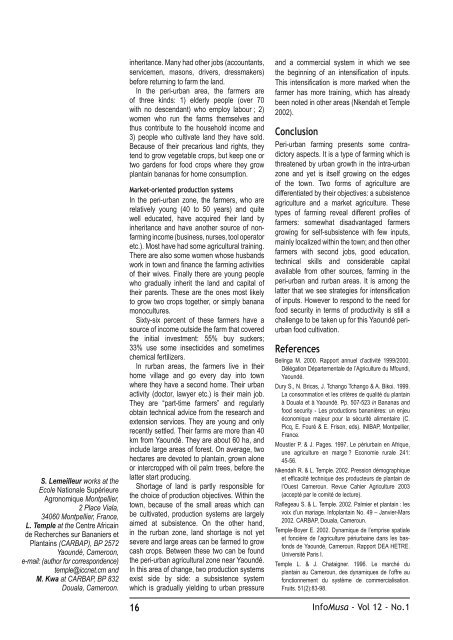Château-Musa - Bioversity International
Château-Musa - Bioversity International
Château-Musa - Bioversity International
You also want an ePaper? Increase the reach of your titles
YUMPU automatically turns print PDFs into web optimized ePapers that Google loves.
S. Lemeilleur works at the<br />
Ecole Nationale Supérieure<br />
Agronomique Montpellier,<br />
2 Place Viala,<br />
34060 Montpellier, France,<br />
L. Temple at the Centre Africain<br />
de Recherches sur Bananiers et<br />
Plantains (CARBAP), BP 2572<br />
Yaoundé, Cameroon,<br />
e-mail: (author for correspondence)<br />
temple@iccnet.cm and<br />
M. Kwa at CARBAP, BP 832<br />
Douala, Cameroon.<br />
inheritance. Many had other jobs (accountants,<br />
servicemen, masons, drivers, dressmakers)<br />
before returning to farm the land.<br />
In the peri-urban area, the farmers are<br />
of three kinds: 1) elderly people (over 70<br />
with no descendant) who employ labour ; 2)<br />
women who run the farms themselves and<br />
thus contribute to the household income and<br />
3) people who cultivate land they have sold.<br />
Because of their precarious land rights, they<br />
tend to grow vegetable crops, but keep one or<br />
two gardens for food crops where they grow<br />
plantain bananas for home consumption.<br />
Market-oriented production systems<br />
In the peri-urban zone, the farmers, who are<br />
relatively young (40 to 50 years) and quite<br />
well educated, have acquired their land by<br />
inheritance and have another source of nonfarming<br />
income (business, nurses, tool operator<br />
etc.). Most have had some agricultural training.<br />
There are also some women whose husbands<br />
work in town and finance the farming activities<br />
of their wives. Finally there are young people<br />
who gradually inherit the land and capital of<br />
their parents. These are the ones most likely<br />
to grow two crops together, or simply banana<br />
monocultures.<br />
Sixty-six percent of these farmers have a<br />
source of income outside the farm that covered<br />
the initial investment: 55% buy suckers;<br />
33% use some insecticides and sometimes<br />
chemical fertilizers.<br />
In rurban areas, the farmers live in their<br />
home village and go every day into town<br />
where they have a second home. Their urban<br />
activity (doctor, lawyer etc.) is their main job.<br />
They are “part-time farmers” and regularly<br />
obtain technical advice from the research and<br />
extension services. They are young and only<br />
recently settled. Their farms are more than 40<br />
km from Yaoundé. They are about 60 ha, and<br />
include large areas of forest. On average, two<br />
hectares are devoted to plantain, grown alone<br />
or intercropped with oil palm trees, before the<br />
latter start producing.<br />
Shortage of land is partly responsible for<br />
the choice of production objectives. Within the<br />
town, because of the small areas which can<br />
be cultivated, production systems are largely<br />
aimed at subsistence. On the other hand,<br />
in the rurban zone, land shortage is not yet<br />
severe and large areas can be farmed to grow<br />
cash crops. Between these two can be found<br />
the peri-urban agricultural zone near Yaoundé.<br />
In this area of change, two production systems<br />
exist side by side: a subsistence system<br />
which is gradually yielding to urban pressure<br />
16<br />
and a commercial system in which we see<br />
the beginning of an intensification of inputs.<br />
This intensification is more marked when the<br />
farmer has more training, which has already<br />
been noted in other areas (Nkendah et Temple<br />
2002).<br />
Conclusion<br />
Peri-urban farming presents some contradictory<br />
aspects. It is a type of farming which is<br />
threatened by urban growth in the intra-urban<br />
zone and yet is itself growing on the edges<br />
of the town. Two forms of agriculture are<br />
differentiated by their objectives: a subsistence<br />
agriculture and a market agriculture. These<br />
types of farming reveal different profiles of<br />
farmers: somewhat disadvantaged farmers<br />
growing for self-subsistence with few inputs,<br />
mainly localized within the town; and then other<br />
farmers with second jobs, good education,<br />
technical skills and considerable capital<br />
available from other sources, farming in the<br />
peri-urban and rurban areas. It is among the<br />
latter that we see strategies for intensification<br />
of inputs. However to respond to the need for<br />
food security in terms of productivity is still a<br />
challenge to be taken up for this Yaoundé periurban<br />
food cultivation.<br />
References<br />
Belinga M. 2000. Rapport annuel d’activité 1999/2000.<br />
Délégation Départementale de l’Agriculture du Mfoundi,<br />
Yaoundé.<br />
Dury S., N. Bricas, J. Tchango Tchango & A. Bikoi. 1999.<br />
La consommation et les critères de qualité du plantain<br />
à Douala et à Yaoundé. Pp. 507-523 in Bananas and<br />
food security - Les productions bananières: un enjeu<br />
économique majeur pour la sécurité alimentaire (C.<br />
Picq, E. Fouré & E. Frison, eds). INIBAP, Montpellier,<br />
France.<br />
Moustier P. & J. Pages. 1997. Le périurbain en Afrique,<br />
une agriculture en marge ? Economie rurale 241:<br />
45-56.<br />
Nkendah R. & L. Temple. 2002. Pression démographique<br />
et efficacité technique des producteurs de plantain de<br />
l’Ouest Cameroun. Revue Cahier Agriculture 2003<br />
(accepté par le comité de lecture).<br />
Raflegeau S. & L. Temple. 2002. Palmier et plantain : les<br />
voix d’un mariage. Infoplantain No. 49 – Janvier-Mars<br />
2002. CARBAP, Douala, Cameroun.<br />
Temple-Boyer E. 2002. Dynamique de l’emprise spatiale<br />
et foncière de l’agriculture périurbaine dans les basfonds<br />
de Yaoundé, Cameroun. Rapport DEA HETRE.<br />
Université Paris I.<br />
Temple L. & J. Chataigner. 1996. Le marché du<br />
plantain au Cameroun, des dynamiques de l’offre au<br />
fonctionnement du système de commercialisation.<br />
Fruits. 51(2):83-98.<br />
Info<strong>Musa</strong> - Vol 12 - No.1

















